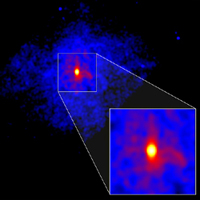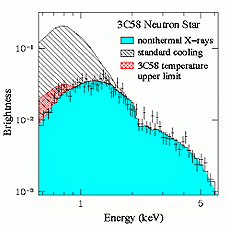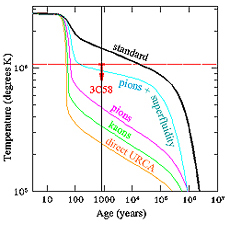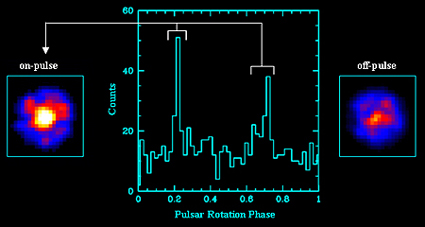Cosmic X-rays May Reveal New Form of Matter

Chandra's X-ray Image of 3C58:
Pullout box shows the inner nebula
Credit: NASA/SAO/CXC/P.Slane et al.
3C58 is a young supernova remnant believed to have resulted from an explosion in the year 1181 A.D. At its center is a pulsar - a highly magnetized, rapidly rotating neutron star. This young neutron star is embedded in extended emission that is presumably produced by energetic particles that are accelerated in the rotating magnetic field.
Neutron stars are born extremely hot. Although neutron stars cool very rapidly, X-radiation from the surface of a star as young as that in 3C58 should be readily observable. However, this 820-year-old star, has apparently cooled so quickly that its X-ray emission has already faded below detectability.
In order to set a limit on the temperature of the neutron star in 3C58, the scientists had to disentangle the possible contribution of X-rays from hot neutron star surface from the synchrotron X-rays due to high-energy electrons spiraling in the rapidly rotating magnetic field of the neutron star.
These synchrotron X-rays are pulsed; as the neutron star rotates 15 times a second, the poles of its magnetic field sweep past the line of sight to Earth, causing pulsed emission. A plot of the brightness of the X-radiation from the 3C58 pulsar (below, center) clearly shows the pulses.

Plot of expected X-ray spectrum (X-ray brightness versus energy of X-rays) for different models.
Credit: NASA/SAO/CXC/P.Slane et al.
The image on the left (above) shows the bright core of the inner nebula, as observed during times of the pulsar peaks.
The image at the right (above) shows the same core region using only times outside of the sharp pulses. Much fainter emission is seen. Even if all of this unpulsed emission comes from X-radiation from the neutron star surface, it is much fainter than expected, meaning that the temperature of the surface is much cooler than predicted by standard models.
The graph on the right shows that the X-rays from the center of 3C58 are well described by the synchrotron model. The expected thermal emission from the hot surface of a standard neutron star model with an age of 820 years is indicated by the black hatched region, and is clearly not observed. The red crosshatched region corresponds to X-ray emission expected at a temperature of about a million degrees. This, too, falls above the observed data. The temperature of the neutron star must be less than 1.1 million degrees Celsius.

The predicted variation of the surface temperature of a neutron star with time.Standard refers to a neutron star composed mostly of neutrons. Pions and kaons are subnuclear particles that may be stable at the high densities inside neutron stars. The Direct URCA process involves the direct decay of neutrons into protons at high densities.
Credit: NASA/SAO/CXC/P.Slane et al.
The interior of a neutron star cools rapidly soon after birth as neutrinos produced by collisions between neutrons and other subatomic particles carry away energy from the hot interior. The cooling due to neutrino energy loss depends critically on the density and composition of the interior of the star, so measurement of the temperature of a neutron star provide a means for probing its interior.
The predicted decline of temperature with time is shown in the accompanying graph for standard models. Also shown are predictions for more rapid neutrino production rates associated with exotic particles and other processes.
The unexpectedly cool temperature of the surface of the pulsar in 3C58 indicates that a form of matter that transcends normal nuclear material - material containing subnuclear particles such as pions - must be present to enhance the cooling.
Return to RX J1856.5-3754 / 3C58




